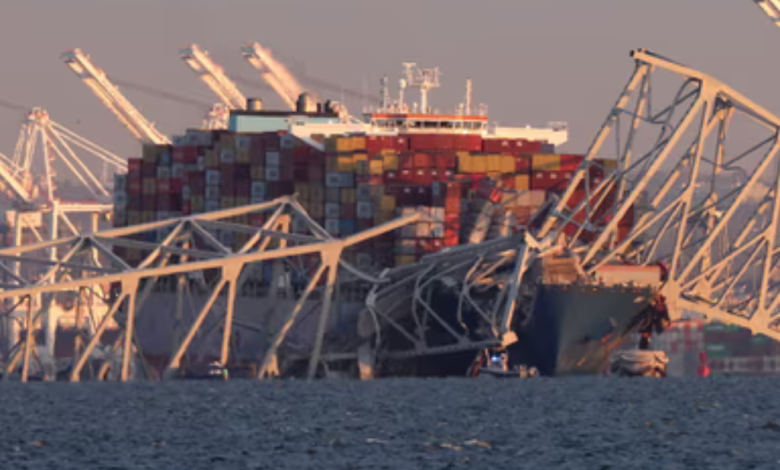Six workers likely dead after Baltimore’s Key Bridge falls down when a big ship crashes into it

Overview of the bridge collapse incident
The collapse of the Key Bridge in Baltimore has sent shockwaves through the city and its surrounding areas. This iconic transportation link, connecting Baltimore to its neighboring regions, tragically crumbled into the Patapsco River, leaving residents and commuters in a state of chaos and disbelief.
The collapse raises serious concerns about the safety and maintenance of infrastructure, prompting a thorough examination of aging bridges across the nation.
Reports of the collapse began flooding in as witnesses, both near and far, watched in horror as the bridge succumbed to its weight. The Key Bridge, known for its historical significance and importance in the region, had been a symbol of connection and accessibility for decades. Now, it stands as a stark reminder of the fragility of infrastructure and the potential consequences of neglect.
Rescue teams swiftly responded to the incident, mobilizing efforts to assess the damage and search for any potential survivors. The immediate response was a testament to the dedication and bravery of first responders, who risked their lives to ensure the safety of those affected by the collapse.
As authorities urged residents to avoid the area and seek alternative routes, the impact of the bridge’s collapse on transportation and the local community began to unfold.
Causes and factors leading to the collapse
While investigations into the exact causes of the Key Bridge collapse are still ongoing, preliminary findings point to a combination of factors that may have contributed to the catastrophic event. The age of the bridge, coupled with a lack of regular maintenance and inspection, is believed to have played a significant role in its ultimate failure.
Infrastructure experts have long warned about the dangers of neglecting aging bridges and the need for consistent monitoring and repairs. The Key Bridge, like many others across the country, had seen years of wear and tear without adequate attention. As time took its toll on the structure, cracks and weaknesses likely formed, eventually leading to the collapse.
Additionally, the weight of heavy traffic and the impact of extreme weather conditions, such as severe storms and flooding, may have further weakened the bridge’s structural integrity. These factors, combined with a lack of timely repairs, created a dangerous situation that culminated in the collapse.
Immediate response and rescue efforts
In the aftermath of the Key Bridge collapse, emergency response teams sprang into action, working tirelessly to assess the extent of the damage and rescue any potential survivors. The immediate response was characterized by a coordinated effort among various agencies, including firefighters, police, and medical personnel.
As rescue teams navigated the treacherous conditions caused by the collapsed bridge, their focus remained on saving lives and ensuring the safety of those in the vicinity.
The inherent dangers of such operations were magnified by the uncertainty surrounding the stability of the remaining structure. Nevertheless, their unwavering dedication and expertise allowed for a swift and efficient response.
The rescue efforts extended beyond the initial response, with teams diligently searching the river and its surroundings for any individuals who may have been trapped or swept away by the collapse. Their commitment to finding potential survivors offered a glimmer of hope amidst the devastation.
Impact on transportation and the local community
The collapse of the Key Bridge has had a significant impact on transportation in the region, causing immediate disruptions and long-term ramifications. With the bridge now out of commission, commuters are faced with the daunting task of finding alternative routes to navigate their daily journeys.
The sudden loss of a vital transportation link has created a ripple effect, leading to increased traffic congestion on alternative routes. Major thoroughfares that were once relied upon for smooth travel have now become congested and overwhelmed. The resulting delays and extended commute times have left commuters frustrated and seeking alternative solutions.
Beyond the realm of transportation, the collapse has also had a profound impact on the local community. The Key Bridge served as a symbol of connectivity and accessibility, enabling residents to easily access employment, education, and recreational opportunities. Its absence has disrupted the daily lives of countless individuals and businesses, highlighting the vital role infrastructure plays in fostering thriving communities.
Investigation and accountability
In the wake of the Key Bridge collapse, investigations are underway to determine the root causes of the incident and identify any parties responsible for negligence or inadequate maintenance. These investigations will play a crucial role in holding accountable those who may have contributed to the collapse and ensuring that similar incidents are prevented in the future.
Experts in infrastructure engineering and safety will meticulously examine the bridge’s design, construction, and maintenance records to pinpoint any shortcomings or oversights. Additionally, regulatory bodies and government agencies will scrutinize inspection protocols and prioritize the implementation of necessary reforms to prevent future bridge failures.
Accountability will be a key aspect of the investigation, as it is essential to both provide justice for those affected by the collapse and send a message about the importance of proper maintenance and oversight. The findings of the investigation will undoubtedly shape future policies and regulations surrounding infrastructure safety.
Rebuilding and future plans for the Key Bridge
As the investigation unfolds, attention will turn to the process of rebuilding the Key Bridge and restoring a vital transportation link for the region. Reconstructing a bridge of this magnitude requires careful planning, engineering expertise, and significant financial resources.
The rebuilding process will involve a comprehensive assessment of the bridge’s remaining structure to determine the extent of the damage and the feasibility of restoration. Designing a new, structurally sound bridge will require innovative engineering solutions that prioritize both functionality and longevity.
The timeline for rebuilding the Key Bridge will depend on various factors, including the availability of funding, the complexity of the project, and the coordination of multiple stakeholders. In the meantime, commuters and residents will need to adapt to the alternative routes and transportation options available to them.
Looking beyond the immediate restoration efforts, the collapse of the Key Bridge serves as a wake-up call for the nation to invest in the maintenance and modernization of its aging infrastructure. The incident highlights the critical need for proactive measures to ensure the safety and resilience of bridges and other transportation networks.
Lessons learned from the bridge collapse
The collapse of the Key Bridge serves as a stark reminder of the consequences of neglecting aging infrastructure. It underscores the urgency of implementing robust maintenance and inspection protocols to identify and address potential vulnerabilities before they escalate into catastrophes.
One of the key lessons learned from this incident is the need for regular inspections and repairs of bridges, particularly those that have exceeded their intended lifespan. Aging infrastructure requires proactive investments to extend its usability and safeguard the communities that rely on it.
Furthermore, the Key Bridge collapse emphasizes the importance of prioritizing infrastructure spending and allocating sufficient resources for maintenance and upgrades. By investing in infrastructure projects, governments can stimulate economic growth, enhance public safety, and improve the overall quality of life for their citizens.
Similar incidents and bridge safety measures
While the Key Bridge collapse is a devastating event, it is not an isolated incident. Throughout history, various bridges have experienced similar failures, often with tragic consequences. These incidents serve as reminders of the ongoing need for vigilance and proactive measures to ensure bridge safety.
In response to past bridge failures, engineering and safety standards have evolved, leading to improved design practices and inspection protocols. The lessons learned from these incidents have informed the development of more robust construction techniques and the implementation of regular maintenance programs.
Bridges are now subjected to rigorous inspections, both visual and technological, to identify any signs of deterioration or structural weaknesses. Advanced monitoring systems, such as sensors and drones, aid in the early detection of potential issues, allowing for timely repairs and preventive measures.
Conclusion and reflections on the Key Bridge collapse
The collapse of the Key Bridge in Baltimore has shaken the community and prompted a much-needed conversation about the state of infrastructure across the nation. This catastrophic event serves as a stark reminder of the importance of investing in the maintenance and modernization of aging bridges.
As the investigation into the causes of the collapse continues, it is imperative that policymakers, engineers, and communities come together to address the vulnerabilities in our infrastructure. By prioritizing infrastructure spending and implementing comprehensive maintenance programs, we can ensure the safety and longevity of our transportation networks.
The Key Bridge collapse should serve as a call to action, prompting a renewed commitment to bridge safety and a dedication to preventing similar incidents in the future. Through proactive measures, accountability, and ongoing investments, we can build a more resilient infrastructure that supports thriving communities and protects the well-being of all who rely on it.



